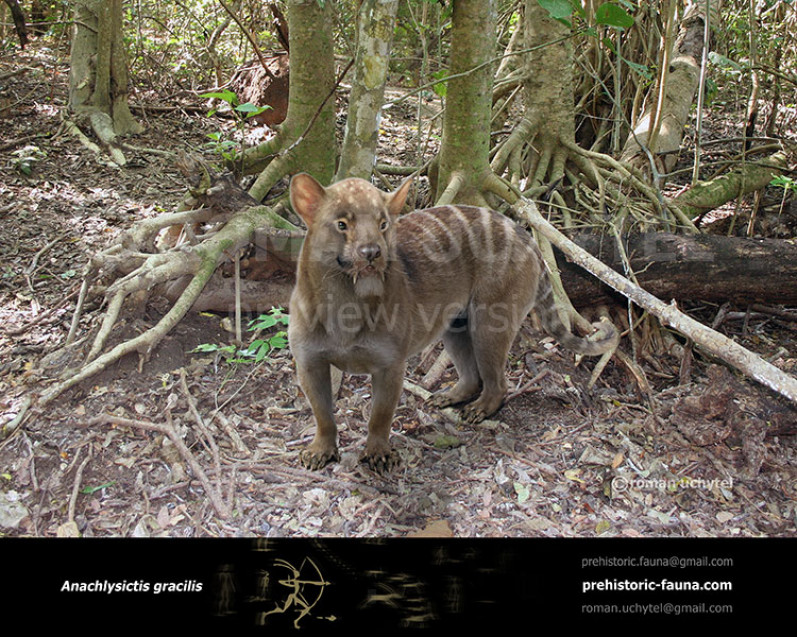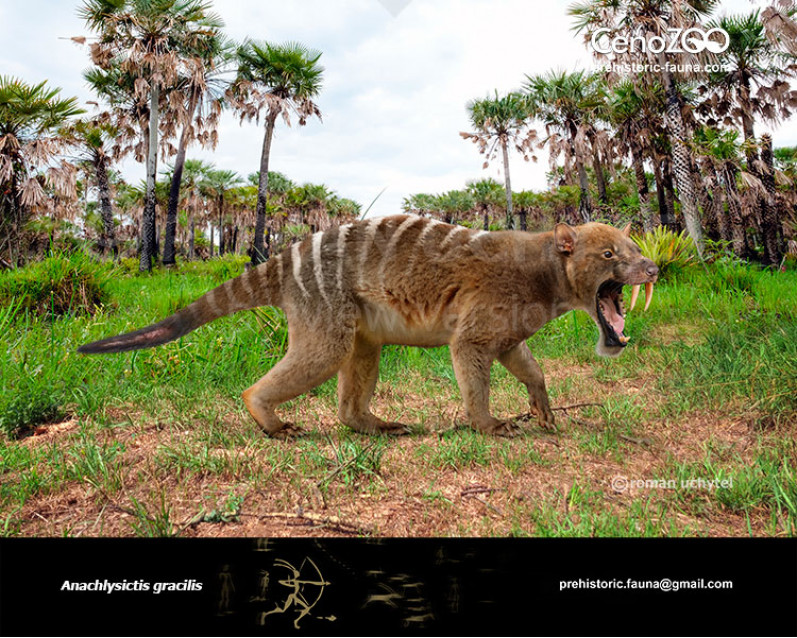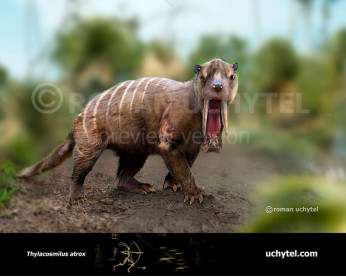Anachlysictis gracilis
257257Anachlysictis (Anachlysictis gracilis Goin, 1997)
Infraclass: Metatheria
Order: †Sparassodonta
Family: †Thylacosmilidae
Temporal range: South America during the mid-Miocene
Dimensions: length - 90 cm, tail - 50cm, height - 50 сm, weight - 18 kg
A typical representative: Anachlysictis gracilis
Anachlysictis is an extinct genus of carnivorous mammals belonging to the group Sparassodonta who inhabited South America during the Cenozoic. This predator belongs to the Thylacosmilidae and is considered the earliest primitive and their representative in the northern part of South America. This species was found in the formation of Villavieja near La Venta in Colombia, in sediments dating from the mid-Miocene (13-11 million years ago). Basis served fragments that include the front part of the lower jaw with the several molars and several teeth of the front portion of the upper jaw. Anachlysictis was less than Thylacosmilus and weighed about 18 kilograms. Flanges on its lower jaw were not so impressive, suggesting a relatively short upper canines. Hollow skulls were not closed, as in its later relatives. Interestingly, before the discovery of the Anachlysictis is not supposed Thylacosmilus was a close relative of the family Borhyaenidae, but the most primitive characteristics and age of the Anachlysictis suggest the origin of the superfamily Thylacosmilids from the Borhyaenoidea. Anachlysictis molars are very similar to those of the little-known Hondadelphys, also from La Venta, which is the oldest representative of opossums. Currently, it is considered a member of a primitive Sparassodonta, and may be related Thylacosmilidae.
Anachlysictis (Anachlysictis gracilis Goin, 1997)
Infraclass: Metatheria
Order: †Sparassodonta
Family: †Thylacosmilidae
Temporal range: South America during the mid-Miocene
Dimensions: length - 90 cm, tail - 50cm, height - 50 сm, weight - 18 kg
A typical representative: Anachlysictis gracilis
Anachlysictis is an extinct genus of carnivorous mammals belonging to the group Sparassodonta who inhabited South America during the Cenozoic. This predator belongs to the Thylacosmilidae and is considered the earliest primitive and their representative in the northern part of South America. This species was found in the formation of Villavieja near La Venta in Colombia, in sediments dating from the mid-Miocene (13-11 million years ago). Basis served fragments that include the front part of the lower jaw with the several molars and several teeth of the front portion of the upper jaw. Anachlysictis was less than Thylacosmilus and weighed about 18 kilograms. Flanges on its lower jaw were not so impressive, suggesting a relatively short upper canines. Hollow skulls were not closed, as in its later relatives. Interestingly, before the discovery of the Anachlysictis is not supposed Thylacosmilus was a close relative of the family Borhyaenidae, but the most primitive characteristics and age of the Anachlysictis suggest the origin of the superfamily Thylacosmilids from the Borhyaenoidea. Anachlysictis molars are very similar to those of the little-known Hondadelphys, also from La Venta, which is the oldest representative of opossums. Currently, it is considered a member of a primitive Sparassodonta, and may be related Thylacosmilidae.



-797x638.jpg)


-70x56.jpg)
